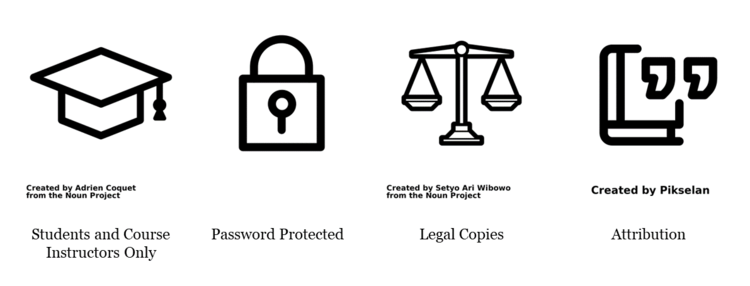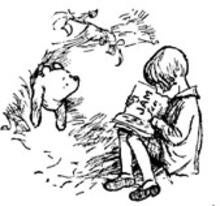The below provides guidance on using third-party images/figures/tables/diagrams, etc. (i.e. materials created by others) in your slides or other lecture material. The guide assumes that:
- Your slides/lecture material are restricted to current students, staff, and instructors associated with your course.
- If you are providing copies of your slides/lectures to the students in your course, you are doing so through a password-protected platform like LEARN or Course Reserves.
- You are working with a legal copy of the content. See FAQ 17: How can I tell if the materials I find online are legal copies? for more information.
- You are providing credit to your sources. See FAQ 13: Do I have to cite my sources? What does a citation have to include? for more information.
- The Copyright Act requires that authors be cited but does not specify a citation style. If you are using content under a Copyright Act exception, such as fair dealing, your credit lines and/or citations should follow the style common in your discipline.
- An example of one method you can use is the credit line:
- If the source is: Konok, V., Korcsok, B., Miklosi, A., Gasci, M. (2018). Should we love robots? - The most like qualities of companion dogs and how they can be implemented in social robots. Computers in Human Behavior, 80, pp. 132-142, https://doi.org/10.1016/j.chb.2017.11.002, then your credit line, in APA style, might be one of:
- Konok et al (2018).
- Adapted from Konok et al (2018).
- Konok et al (2018). Reproduced with permission.
- Note that content cleared through a licence or terms of use may require a specific citation style. The agreement will specify what is required.
Remember

Tip: Use open content, where possible
Use Creative Commons licensed or other openly licensed images wherever possible. Images with these licences are designed to be shared and reused, as long as they are cited. CEL’s Suggested sources for free images, video and audio is a good place to start your search.
Content from a book or other print source
You may be able to use fair dealing to clear copyright. The Fair Dealing Advisory allows up to 10% or one chapter of a book to be copied without permission. You may copy images and similar items under this advisory. Note that you can’t double dip; that is, you can’t use the Advisory to copy images for your slides and 10% of a work for Course Reserves. You also can’t use 10% or less of the content for one lecture and more content for another lecture; the limit is for the course as a whole.
An example:
You are using the textbook Perspectives on Animal Behavior by Goodenough, McQuire & Jakob. The book is 544 pages long. You want to use three images in a slide deck, one on page 10, one on page 251, and one on page 500. This would be considered using three pages of 544, amounting to 0.5% of the book. As this is less than 10% you may use the content in the book without asking permission. You must provide attribution in the form of a credit line or citation.
Content from a freely available website
You may be able to use one of two Copyright Act exceptions.
- Fair Dealing: See the Fair Dealing Advisory for more.
- Work available through the Internet. This exception allows you to copy an entire work that has been made available on the internet without permission as long as you meet a set of five requirements. These requirements are listed in the example provided below.
An example:
You want to use the Plains Zebra infographic available on the PBS Nature site, Infographic: All About the Plains Zebra in a slide deck in Zoology 100, and upload a copy of it to the LEARN space for the course.
| Requirement |
Your Action |
|---|
| You are reasonably certain that the copy of the work is a legal copy. |
The work was published on the PBS website and is labelled with the PBS and Nature logos. A search of tineye.com reveals that the image exists in two places online, according to their index, and the PBS website is where it seems to have been published first. These two pieces of information help us have confidence that the images are legal copies. |
| You do not bypass any technological protection measures (e.g., password protection, or digital rights management software [e.g., Adobe Digital Editions]). |
The PBS page is not password-protected and the image does not have any form of digital rights management attached to it (you can right click and save the image without issue). |
| There is no clearly visible notice prohibiting copying on the website. The notice must be more than simply the copyright symbol (©). |
The image is labelled with the copyright symbol (©) alone. There are no notices on the webpage prohibiting copying. |
| You are providing access to only students registered in the course. |
Only the students in Zoology 100 will have access. |
| You'll provide attribution to the creator where available. |
On the slide that includes the image you’ll include a caption that states: Source: Brazell & Fulton (2013). |
Content from an electronic book or journal article
The licences the Library signs with publishers indicate what you can do with electronic content you use through the Library (online articles, eBook chapters, digital newspapers, etc.). Basic licence information is made available in Omni, the library catalogue. The finding usage rights page provides instructions on how to use Omni to see basic licence permissions for content. When checking to see if you can use content in your slides look for: "LEARN Use Permitted: Yes."
An example:
You want to use Figure 2 from Common dolphin morphotypes: Niche segregation or taxonomy? in the Journal of Zoology. The catalogue record for the Journal of Zoology shows “LEARN Use Permitted: Yes”, which means you can use the figure in your slides. The attribution (credit line/citation) format is not stipulated, so you should follow the style of your discipline.
Embedding YouTube content
Embedding YouTube content in your slides is similar to linking to it, in that as long as you are linking to a legal copy, you can do so. “Embedding” means that the content remains on YouTube's servers and, via embed code provided by YouTube, plays in your lecture. Note, although the student does not have to go to YouTube to watch the embedded video, the content will not be available to students in countries where access to YouTube is blocked.
An example:
You want to embed the video Can Penguins Fly?: Weird Animal Searches posted on the BBC Earth YouTube account in your slides.
Given that the video was posted to the BBC Earth account, the account has been verified by YouTube, the channel indicates that it is a commercial channel from BBC Studios, and that BBC Earth's website links to this channel, it is reasonable to assume that the video is a legal copy. You can embed the video in your slides. It is good practice to include a citation to the video in your slides, but it is not required.
Important note: Public domain content
None of the above applies if you are using public domain content (content where copyright has expired, where the author has been dead for more than 50 years). More information about the public domain is available in FAQ 17.
An example:
You want to use the an image of Winnie the Pooh from the original A.A. Milne books. A.A. Milne, the original creator of Winnie the Pooh, died in 1956, so the work is in the public domain and can be used freely.
Image sources:
student by Adrien Coquet from Noun Project
Lock by Storm Icons from Noun Project
legal by Setyo Ari Wibowo from Noun Project
citation by Pikselan from Noun Project
books by Olga from Noun Project
website by Yeyen from Noun Project
ebook by SBTS from Noun Project

 Content from a book or other print source
Content from a book or other print source






